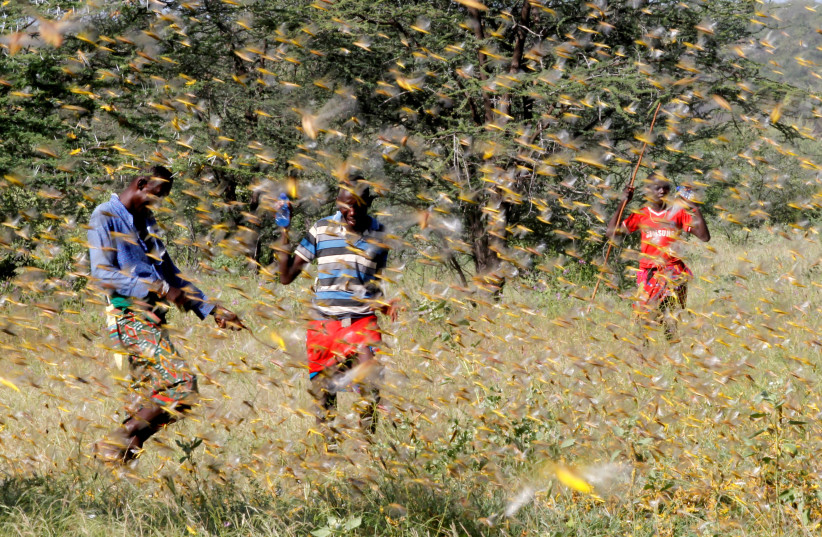Second wave of locusts striking hard-hit East Africa
Huge swarms on scales that had not been seen in decades were reported last year in East Africa, parts of the Arabian Peninsula, Iran, Iraq, Pakistan and India.
By Tzvi Joffre , Jerusalem Post, January 25, 2021

Samburu men attempt to fend-off a swarm of desert locusts flying over a grazing land in Kenya, 2020 (photo credit: NJERI MWANGI/RE )
A second wave of desert locust swarms has begun striking an already hard-hit East Africa
in recent weeks after heavy rains and a late-season cyclone sparked a
new round of breeding, with swarms invading Kenya and southern Ethiopia,
according to the Food and Agriculture Organization (FAO) of the United
Nations.
The first wave
of locusts was reported in East Africa in January of last year, when
heavy rains sparked a round of largescale breeding, according to FAO.
Weather conditions remained favorable for locust reproduction and
growth throughout the year, feeding outbreaks of locust from East Africa
to Iran.
With the region threatened by a second wave of locusts,
local countries are on "much better footing" than they were at the
beginning of 2020, according to FAO, which stressed that the countries
are better prepared and equipped and that the number of desert locusts
is much smaller than it was in 2020.
"The
last time Africa saw an upsurge of locusts approaching this scale, in
the Sahel, it took two years and more than $500 million to bring under
control. This upsurge was even bigger, but East Africa is poised to end
it -- provided governments can keep those aircraft flying," said FAO
Deputy Director-General Laurent Thomas. "The locust fighting machine
that has been assembled in East Africa is now fully equipped and able to
contain, suppress and we believe, eventually end this record-breaking
upsurge."
Dominique
Burgeon, FAO's director of emergencies and resilience stated that over
three million tonnes of cereals, valued at approximately $940 million,
were protected due to surveillance and response efforts last year,
according to the UN. That's enough to feed 21 million people for a year.
Despite
the optimism, Thomas stressed that the region needed $38.8 million in
additional funding in order to continue fighting the outbreaks through
June.
FAO expects
that a new generation of locust will emerge in early April amid seasonal
rains and the planting season in Kenya and southern Ethiopia. Desert
locusts have also been reported breeding on Somalia's coastline on the
Gulf of Aden.
An
FAO Desert Locust Bulletin from the end of December forecast that swarms
would spread throughout southern Ethiopia, Kenya and the coast of Saudi
Arabia and limited breeding would occur in Sudan, Eritrea, Egypt and
Yemen. Concerning Israel, Jordan, Lebanon and Syria, the forecast stated
that "no significant developments are likely."
The
Famine Early Warning System stated that several parts of the Horn of
Africa are facing food crises caused partially by the locust swarms and
that the crises will worsen in the coming months, especially in
Ethiopia, Sudan and Yemen, according to NPR.
All of this comes as the coronavirus pandemic continues to impact the world's economy and food availability for many people.
Huge
swarms on scales that had not been seen in decades were reported last
year in East Africa, parts of the Arabian Peninsula, Iran, Iraq,
Pakistan and India, with some swarms reaching as wide as 60 kilometers
and covering as much as 240,000 hectares of land, an area the size of
Luxembourg, according to FAO.
A
one sq. km. swarm of locusts can eat the same amount of food in one day
as 35,000 people, according to the FAO. UN Food & Agriculture
Organization locust forecasting expert Keith Cressman explained that a
locust swarm that enters a field in the morning can eat the entire field
by midday. The insects can travel up to 93 miles a day.
😇😇😇😇😇😇😇😇😇😇😇😇😇😇😇😇😇😇😇😇😇😇😇😇😇😇
Neander-Troll says :Be sure to recommend and follow Chucks " Life of Earth " Blog at:https://disqus.com/home/forum/lifeofearth/
Neander-Troll says :Be sure to recommend and follow Chucks " Life of Earth " Blog at:
https://disqus.com/home/forum/lifeofearth/

No comments:
Post a Comment
Stick to the subject, NO religion, or Party politics